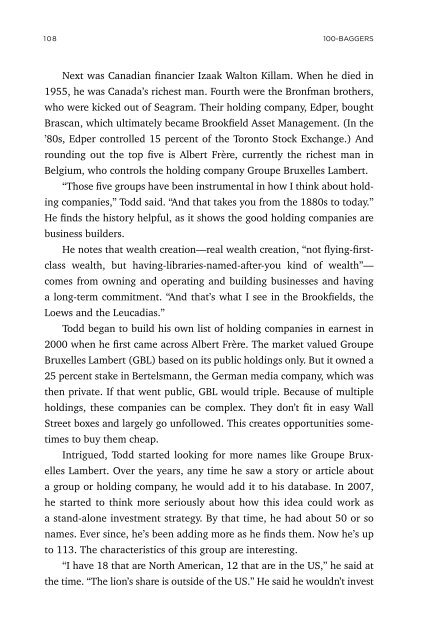You also want an ePaper? Increase the reach of your titles
YUMPU automatically turns print PDFs into web optimized ePapers that Google loves.
108<br />
100-BAGGERS<br />
Next was Canadian financier Izaak Walton Killam. When he died in<br />
1955, he was Canada’s richest man. Fourth were the Bronfman brothers,<br />
who were kicked out of Seagram. Their holding company, Edper, bought<br />
Brascan, which ultimately became Brookfield Asset Management. (In the<br />
’80s, Edper controlled 15 percent of the Toronto Stock Exchange.) And<br />
rounding out the top five is Albert Frère, currently the richest man in<br />
Belgium, who controls the holding company Groupe Bruxelles Lambert.<br />
“Those five groups have been instrumental in how I think about holding<br />
companies,” Todd said. “And that takes you from the 1880s to today.”<br />
He finds the history helpful, as it shows the good holding companies are<br />
business builders.<br />
He notes that wealth creation—real wealth creation, “not flying-firstclass<br />
wealth, but having-libraries-named-after-you kind of wealth”—<br />
comes from owning and operating and building businesses and having<br />
a long-term commitment. “And that’s what I see in the Brookfields, the<br />
Loews and the Leucadias.”<br />
Todd began to build his own list of holding companies in earnest in<br />
2000 when he first came across Albert Frère. The market valued Groupe<br />
Bruxelles Lambert (GBL) based on its public holdings only. But it owned a<br />
25 percent stake in Bertelsmann, the German media company, which was<br />
then private. If that went public, GBL would triple. Because of multiple<br />
holdings, these companies can be complex. They don’t fit in easy Wall<br />
Street boxes and largely go unfollowed. This creates opportunities sometimes<br />
to buy them cheap.<br />
Intrigued, Todd started looking for more names like Groupe Bruxelles<br />
Lambert. Over the years, any time he saw a story or article about<br />
a group or holding company, he would add it to his database. In 2007,<br />
he started to think more seriously about how this idea could work as<br />
a stand-alone investment strategy. By that time, he had about 50 or so<br />
names. Ever since, he’s been adding more as he finds them. Now he’s up<br />
to 113. The characteristics of this group are interesting.<br />
“I have 18 that are North American, 12 that are in the US,” he said at<br />
the time. “The lion’s share is outside of the US.” He said he wouldn’t invest


